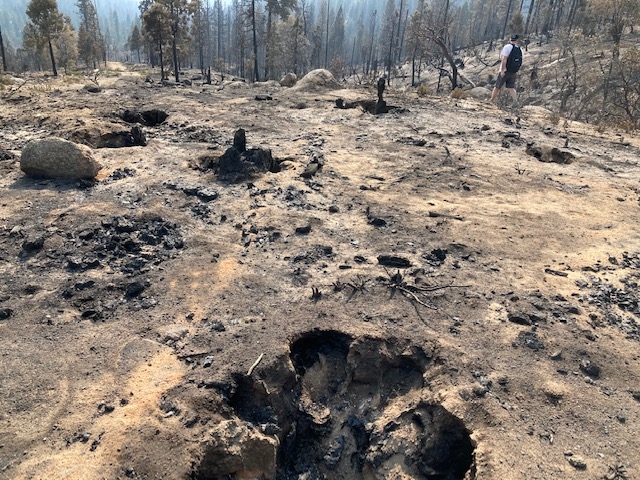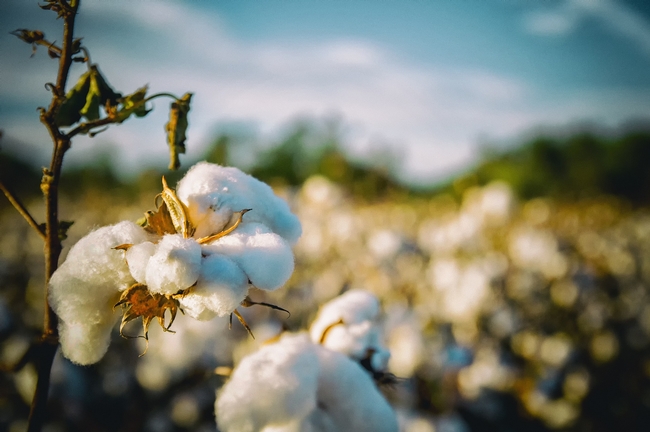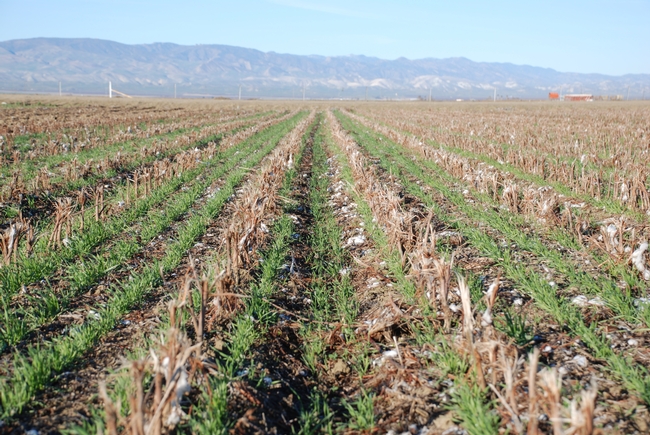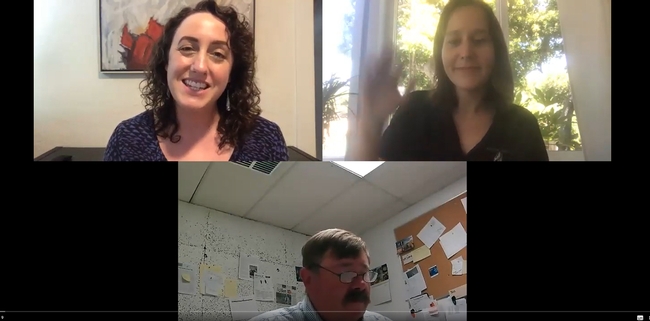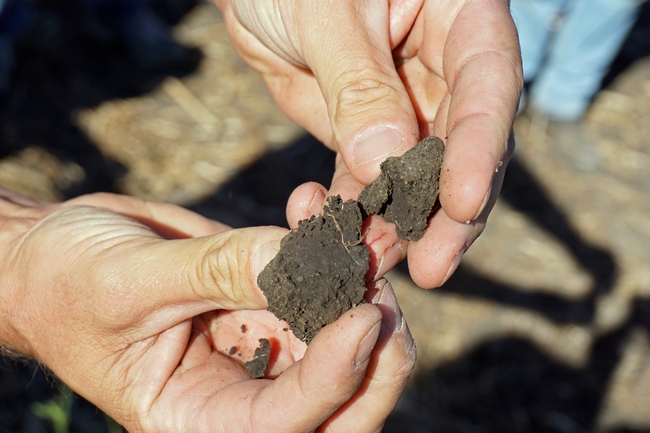Posts Tagged: Soil
Wildfires are devastating to the soil
After another record year for California wildfire, concern is now turning to the soil impacted by firestorms, reported Sarah Klearman in the Napa Valley Register.
High-temperature flames can incinerate vegetation and destroy plant root systems, said Toby O'Geen, UC Cooperative Extension soil specialist at UC Davis. The loss of vegetation destabilizes the landscape, making it vulnerable to serious erosion or flooding.
"The most important way to battle erosion is to have surface cover - living vegetation anchoring your soil," O'Geen said. "We have none of that. If you have soil with existing susceptibility (to erosion) and now nothing to hold it in place, it's a new disaster."
Particularly catastrophic fire can make the soil surface water repellent, which allows water to pond up and release higher concentrations of run-off water even when rainfall is low.
"That creates more massive erosive events - it gives rise to accelerated erosion, and in some extreme instances, mudslides," O'Geen said.
Consumers are driving a move to more sustainable cotton farming in California
Consumers who purchase luxury cotton textiles want more than cool, soft, absorbent fabric. Increasingly, they demand clothing made from fiber grown using ecologically sound practices and they're willing to pay for it, said speakers representing the textile industry at a UC Cooperative Extension webinar on Healthy Soils for Healthy Profits.
A recording of the three-hour Sept. 17 webinar – which features clothing manufacturers, farmers and scientists – may be viewed on YouTube at https://youtu.be/rEm8pjbbnaE.
At the beginning of the webinar, UC Cooperative Extension conservation agriculture specialist Jeff Mitchell recalled the tragic 1991 dust storm on the west side of Fresno County, which reduced visibility on Interstate 5, causing a 104-vehicle pile-up that took 17 lives. The devastating accident foreshadowed debates about agriculture's role in reducing dust emissions, he said.
“It turns out that air quality was just the beginning,” Mitchell said. “There is now a whole cascade of expectations that buyers, consumers and the public are demanding of farmers about how food, fiber, feed and fuel crops are actually produced.”
Speakers from non-profit and commercial fashion and fiber organizations said they are anxious to get access to cotton grown using practices that promote soil health and sequester carbon to give their products climate-change mitigation cachet.
“What we envision when we look at the fields is groundcover year-round. Living roots in the soil year-round,” said Rebecca Burgess, director of Fibershed, a California non-profit organization that develops regional and regenerative fiber systems. “No-till or strip-till practices have garnered interest to protect soil from disruption, to avoid breaking up fungal networks. To produce cotton in a system that isn't eroding top soil.”
Wrangler jeans is a clothing brand that has successfully incorporated sustainably produced cotton into its products. The company worked with a group of Tennessee cotton farmers and the Soil Health Institute to produce 100% sustainable cotton jeans and sell them in its Wrangler Rooted Collection. Men's jeans in the collection run about $100 a pair. Ordinary cowboy cut Wrangler jeans range from $39 to $41 a pair.
Burgess said the fashion and textile industry is organizing itself to align with the 1.5-degree pathway, a target set by the Intergovernmental Panel on Climate Change that limits the rise in global average temperature to no more than 1.5 degrees C above pre-industrial levels.
“We want to work with farmers to enhance the ecosystem function of the landscape,” Burgess said. “We need to embed the cost of transitions into the cost of the cotton.”
Growing regenerative cotton in California comes with challenges that farmers are facing head on. Firebaugh farmer John Teixeira this year grew a multi-species cover crop that he terminated with a flail mower rather than a herbicide. He is making compost on the farm and in some parts of the farm spreading 8 to 10 tons per acre.
“We spread it on soil and also on cover crops to digest the cover crop,” Teixeria said. “We're adding bacteria. We would love to have more fungal diversity in the compost, but that's really hard. Fungi don't like to be disturbed. I believe microbes are the future. The key is to keep them alive.”
Gary Martin of Pikalok Farming in Firebaugh was using poultry manure on the farm, until it became prohibitively expensive. He then turned to cover crops and municipal compost to improve water infiltration, soil structure, water retention and increase organic matter. After three years, he added gypsum to improve the soil health.
He found that planting a cover crop without irrigation is a gamble.
“The net value of the cover crop is negative if it doesn't grow (because of a lack of rain),” Martin said. “Composting is more of a sure bet.”
Bowles Farm is experimenting with using a native plant cover crop.
“Native plants are designed to grow when we get moisture, and go away when we don't,” said Bowles Farm executive vice president Derek Azevedo. “It could be a habitat for pollinators.”
The company is also working on writing a carbon plan to map out how much carbon a cotton farm in Merced County can capture. The trial is managed with a multi-species cover crop, strip tillage, untreated seeds, fungal-dominated compost inoculation and a reduction in synthetic nitrogen.
“I can tell you already that the results of that carbon plan are being awaited by one of the brands in the San Luis Obispo area,” Burgess said. “They want to work with that cotton. They are excited to know what this can do for the climate.”
Rebecca Daeschner represented the Los Angeles-based luxury women's wear brand CO (CO-collections.com), which in its current collection sells a ruched cotton top for $725, a cotton button down shirt for $795 and an a short-sleeved cotton dress for $795.
“We're interested in making products that stand the test of time, stay out of landfills, eliminating waste,” Daeschner said.
The company currently sources its high-end materials mainly from Italy, but is interested in transitioning to fabrics that are not only high quality, but also have a reduced environmental footprint. A new line, CO Natural World, focuses on the highest levels of sustainability, organic and regenerative materials, climate-beneficial wools, organic cotton, organic linen and recycled cashmere from garments that can no longer be salvaged.
“To create a garment that goes beyond the very least amount of harm to a garment that actually benefits the planet is the ultimate luxury,” Daeschner said.
The company is part of a network of five clothing brands that are working together to create the California Cotton and Climate Coalition, or C4 Coalition.
“We can do more together than we can do alone to boost the demand for beneficial cotton,” she said. “We are sharing pre-competitive information and pooling our financial resources to overcome existing gaps in the supply chain. And we will share our findings and results to attract new brands to the coalition.”
Calla Rose Ostrander, climate change communicator with the People, Food and Land Foundation, spoke from her home base in Colorado about opportunities for incentives to assist farmers in transitioning to healthy soils practices. She has been working with Maurice Marciano, the founder of Guess Jeans, and his daughter Olivia, who provided funding for part of the Bowles Farm project.
“They want to give back to the cotton community given the legacy of their company,” she said.
Ostrander said there is a network of philanthropic funders who may be interested in supporting the evolution of the cotton production system.
“There's a lot of commitment out there,” Ostrander said. “We're all trying to figure out how to do it and make sure that we can support the farmers in this transition. I'm really glad to see that the emphasis has stayed on supporting the producer and this idea has evolved. It takes time to build things.”
UC Cooperative Extension and Colusa RCD launch 'Soil Health Connection'
University of California Cooperative Extension and the Colusa County Resource Conservation District announce the launch of the Soil Health Connection, an informative outreach YouTube channel. The channel hosts virtual discussions and interviews with leading soil science researchers and farmers with the intention of shedding light on the importance of soil health in California's agricultural systems.
Hosts Sarah Light, UCCE agronomy advisor, and Liz Harper, Colusa County RCD executive director, bring their own knowledge and expertise to the channel by inviting guests and viewers to think about soil health through various lenses. The channel has already released episodes touching on the connections between soils and economics, agroecology, nutrient management, conservation, regenerative agriculture and more.
Featured guests from a multitude of backgrounds help capture differing perspectives and the interdisciplinary nature of the field of soil health. One episode in Spanish has been released.
Soil Health Connection is a product of Light and Harper's collaborative research supported by the California Department of Food and Agriculture Healthy Soils Program in partnership with Richter AG and Davis Ranch. The project is evaluating how soil moisture dynamics change with and without cover crops in an annual cropping system. In addition to the applied research and demonstration aspect, the project also aims to provide a platform for community outreach and education.
Experts in soil health and related fields, as well as growers participating in soil health practices, are encouraged to email Light at selight@ucanr.edu if interested in participating in the Soil Health Connection.
To learn more about soil health in the Sacramento Valley, tune in to hear from the professionals who are getting their hands dirty with these issues every day. New episodes are released bi-weekly at https://www.youtube.com/channel/UCRI4lXL4f_ro_Flnp4lu6IA.
UC Cooperative Extension to investigate healthy soil practices with CDFA grants
Six UC Cooperative Extension research projects were awarded funding ranging from $100,000 to $250,000 each from the California Department of Food and Agriculture Healthy Soils Program. The grants are designed to fund implementation and demonstration of on-farm soil health practices that reduce greenhouse gas emissions and store carbon.
One of the grant recipients, John Bailey, director of the UC Hopland Research and Extension Center in Mendocino County, will use the $100,000 award to establish a perennial hedgerow at the center. Hedgerows are not traditionally part of standard ranching practices in Mendocino County, where in the past the center's 5,400 acres of rangeland and surrounding areas were grazed by large flocks of sheep.
“At Hopland, we have pivoted our operation to reflect the current state of the sheep industry in California, with reduced overall sheep numbers and decreased individual flock size, so we will use this project to show our smaller-scale sheep owners how they can enhance the ecosystems of their properties,” Bailey said.
Bailey expects the hedgerow to offer many educational, ecological and practical benefits, including enhancing soil health, increasing soil carbon sequestration, and providing habitat and food sources for beneficial organisms, such as pollinators and birds.
There may also be economic benefits to using sustainable practices in raising sheep. The project will explore the financial costs of implementing hedgerows as well as the opportunity for producers to enter a niche fiber market by offering sustainably produced wool to textile companies and consumers willing to pay a premium to support the ecological benefits of Healthy Soil Projects.
“I'm excited about this opportunity to combine the latest knowledge on environmental sustainability practices with the older traditions of livestock grazing in Northern California,” Bailey said. “This is a progressive step that ties in ecological knowledge that can benefit the livestock ranching model by both enhancing their properties and creating new markets for their products.”
The following projects were also funded by CDFA Healthy Soils Program in 2020:
Integrated sustainable nitrogen management in vegetable cropping systems, $250,000
Maria de la Fuente, UCCE county director and advisor, Monterey and Santa Cruz counties
The implementation of climate-smart agricultural practices within intensively managed vegetable cropping systems is extraordinarily challenging. Often conservation practices cannot be effectively implemented due to operational barriers, resulting in very low rates of adoption.
By demonstrating nutrient management strategies in partnership with a large influential vegetable grower in the Salinas Valley, the project aims to encourage broad scale practice adoption.
Recent research has indicated the addition of organic amendments in combination with nitrogen fertilizers potentially reduces nitrogen-derived greenhouse gas emissions and nitrate leaching while increasing soil carbon stocks. These outcomes will generate significant climate benefits in agroecosystems experiencing heavy tillage and fertilizer inputs.
This project has the potential for statewide impact as the researchers are currently working with the developers of COMET-Farm to provide data and coordinate outreach within vegetable cropping systems. Through direct engagement the team will make integrated sustainable nitrogen management more feasible and agronomically favorable for producers.
Using hands-on COMET-Farm-focused field days and a webcasted sustainable nitrogen short course, the project will provide producers with additional tools to make nutrient management planning decisions that have positive climate and soil health outcomes.
Evaluation of compost application to processing tomato fields in the Sacramento Valley, $100,000
Amber Vinchesi-Vahl, UCCE vegetable crops advisor, Colusa, Sutter and Yuba counties
The project will demonstrate compost applications on two farms in two Sacramento Valley counties, Colusa and Sutter. The researchers will work with Westside Spreading LLC and compare two plant-based compost rates to a control (no compost) over three years. Soil health parameters – such as total carbon and nitrogen, pH, EC, organic matter and fertility analyses relevant to tomato crop production – will be measured.
The benefits of compost applications vary depending on how often they are used, how much is applied, crop rotation, and other management decisions, such as whether compost is incorporated or left on the soil surface. Vinchesi-Vahl expects that over time the compost implementation evaluated in this project will result in lower input costs and improved soil function.
Compost application may reduce the need for fertilizer inputs for some of the rotational crops and provide benefits to the microbial community, thereby improving soil structure and reducing heavy conventional tillage needs.
By improving soil health, the research expects plant health will also be improved, leading to better tolerance to pest pressure from diseases and weed competition.
The two demonstration sites will showcase compost applications and their impact on processing tomato production and annual production soil health. These focused demonstrations will be extremely important in showcasing this soil health practice in the local Sacramento Valley region, providing information to growers from the experiences of collaborators at the two sites.
Evaluation of winter cover crop species for their ability to mitigate soil compaction in an annual rotation, $100,000
Sara Light, UCCE agronomy advisor, Sutter, Yuba and Colusa counties
This project has three components:
- Replicated research plots in which three cover crop varieties are evaluated for improvements in soil structure, specifically subsurface soil compaction
- Fieldscale demonstration plots in which varieties thought to reduce soil compaction are planted and visually assessed for performance in the Sacramento Valley
- Small, single-row hand planted plots in the buffer area, in which a wider number of both summer and winter cover crop varieties will be planted for outreach and demonstration purposes
Combined, these components will enable growers to make more informed decisions about cover crop selection and encourage wider adoption of cover cropping. The outreach objective for this project is to reduce barriers to cover crop adaption among regional growers by increasing knowledge and information about varietal selection and field-scale cover crop management, as well as opportunities to improve soil structure using cover crops.
Healthy soils demonstration project with Cardoza Farm, $100,000
Ruth Dahlquist-Willard, UCCE small farms advisor, Fresno and Tulare counties
This project will demonstrate compost application, hedgerow planting, and application of mulch generated from cover crop residue in a vineyard producing organic raisin grapes. Mulch will be applied directly under the vines, providing ground cover that will conserve soil moisture and decrease weed pressure. Generating the mulch on-farm eliminates the need to transport materials from outside sources.
Currently, production of organic raisin grapes involves frequent tillage under the vines. The cover crop between rows and the mulch under the vines will reduce the need for tillage for weed control and increase soil organic matter. These practices will be showcased at field days that will include bilingual training for small-scale, socially disadvantaged farmers in the San Joaquin Valley.
Application of compost to alfalfa to improve soil structure and fertility, $250,000
Kate Scow and Radomir Schmidt, UC Davis Department Land, Air, Water Resources and UCCE advisors Michelle Leinfelder-Miles and Rachael Long
This project will demonstrate compost application to alfalfa for improving soil structure and fertility. Compost is not typically applied to alfalfa; however, manure application to alfalfa is common in the state's dairy regions.
The over half a million acres of alfalfa in California could represent an important repository for compost, for which a large land base of spreading may be needed as municipalities convert organic waste management streams to diversion from landfills.
Alfalfa has the ability to immobilize large amounts of nitrogen and phosphorus, nutrients of concern in the concentration of organic wastes due to their potential to contribute to water pollution. Furthermore, alfalfa growers are interested in the potential of compost to improve soil structure in their alfalfa fields, as many growers report suffering from the large cracks that form in soils during the wet-dry cycles of alfalfa surface irrigation management.
Compost application has been anecdotally reported to alleviate soil cracking in another perennial crop, almond orchards in the Central Valley, but soil structure improvement via management practices like compost application has received little research attention thus far. Westside Spreading LLC is collaborating on this project.
Allie Igwe: The Road to Success
The road to success is paved with soil microbial communities. And education, curiosity, determination, and collaboration. UC Davis doctoral student...

UC Davis doctoral student Alexandria “Allie” Igwe has received a $138,000 National Science Foundation Postdoctoral Fellowship to work on soil microbial communities and develop novel online tools to increase interest in ecology.


